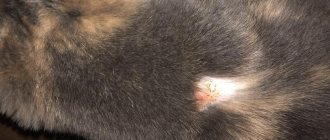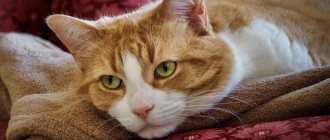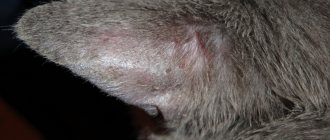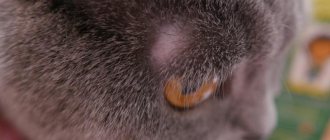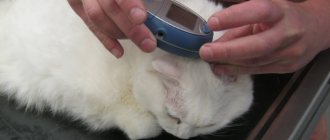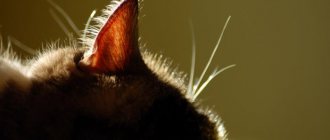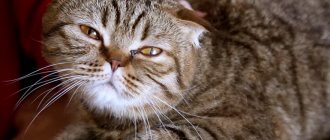If a cat has an ulcer on the nose, this may be a sign of pathologies such as infection with pathogenic microflora, an allergic reaction, polyps, or traumatic injuries. In addition to wounds, the condition may be accompanied by fever, sneezing, coughing, and changes in the animal’s behavior. At the first symptoms, it is recommended to take your pet to a veterinarian, who will prescribe medications or perform surgery.
According to statistics, timely treatment of calicivirus saves the lives of 80% of animals.
The wound must be clean
In a purulent wound there may be scabs, necrosis, crusts, fibrin (this is yellow dense tissue on the wound), then such a wound must be cleaned. Cleansing can be achieved using Neofix FibroGel AG, IntraSite Gel and IntraSite Conformable hydrogels. The main purpose of these gels is to moisten necrosis and crusts, loosen them, which facilitates easier removal of necrosis during subsequent dressings. Hydrogels are applied directly to the wound in sufficient quantities so that the wound is completely covered with hydrogel; the hydrogel layer must be at least 5 mm. Next, the wound must be covered with a film dressing, for example OpSite Flexigrid, or one of the postoperative dressings OpSite Post-Op, PRIMAPORE, NEOFIX Post. On top of the gels, you can use absorbent dressings Allevyn Adhesive or Allevyn Sacrum, which are preferable and more convenient to use in the treatment of bedsores, since these dressings have a sticky edge and a soft spongy pad. After a maximum of three days, it is necessary to bandage, remove the hydrogel from the surface of the wound, and along with it the softened necrosis and crusts. If there are areas of necrosis or stupa remaining in the wound, then it is necessary to use the hydrogel more than once until the wound is completely cleansed. The advantage of using the antimicrobial hydrogel Neofix FibroGel AG for these purposes is that this hydrogel contains silver. This antimicrobial component fights any infectious agents in the wound. As a result of the use of hydrogels, the wound is cleaned. Dressings must be carried out at least once every 1-3 days, and preferably under the supervision of the attending physician.
Treatment: what to do with necrosis?
Tissue necrosis in cats can be cured by surgery. To prevent the spread of cell death due to bacterial infection, antibiotics are effective, which the veterinarian prescribes individually. To dry out necrosis, disinfect and identify clear boundaries of the lesion, dead tissue is smeared with brilliant green or Chlorhexidine. To prevent the cat from licking the medicine and getting poisoned, the limb should be bandaged and a special collar should be put on the neck.
Necrotic areas on internal organs are excised or a complete ectomy is performed. External lesions are treated by necrectomy, in which areas of necrosis in the cat are removed with a small inclusion of healthy tissue. In case of wet type of pathology or gangrene, amputation of the limb is performed. After the stump has healed and scarred, a prosthesis is installed.
The infection must be suppressed
To combat infection in a wound, it is best to use ACTICOAT and ACTICOAT7 dressings. These are mesh absorbent dressings that allow unimpeded drainage of exudate from the wound and fight infection. These dressings contain silver. The antibacterial activity of silver has been known for many years and its effectiveness is beyond doubt. The activity of silver is not affected by the presence of blood and pus in the wound. All causative agents of wound infections, including antibiotic-resistant bacteria, are not resistant to silver. Silver has a universal, wide spectrum of action, including against mixed microflora containing various bacteria, fungi, and yeast. The use of dressings with silver leads to rapid suppression of the inflammatory reaction in the wound, and at the same time the amount of discharged exudate decreases.
It is important that the silver in ACTICOAT and ACTICOAT7 dressings begins to be released immediately as soon as the dressing is applied to the wound, and quickly, within the first 30 minutes, the necessary concentration of silver is achieved in the wound to fight infection, and this concentration of silver is maintained at a constant level throughout long-term - up to 3 days when using ACTICOAT dressings and up to 7 days when using ACTICOAT7 dressings, thereby ensuring long-term antibacterial activity of the dressings, so the ACTICOAT dressing can be on the wound for up to 3 days, and the ACTICOAT7 dressing up to 7 days, with external absorbent dressings (gauze or Allevyn sponge) must be changed daily.
Use an acticoate dressing to effectively fight infection.
Prevention
To avoid external necrosis in a cat, veterinarians recommend not leaving your pet in the cold, protecting it from burns, and putting away household chemicals or dangerous objects that the pet can swallow (rubber bands, ribbons, New Year’s rain, polyethylene). Exposed wires should not be left unattended if the house is undergoing renovations. Even minor wounds and scratches should be treated promptly, and deeper cuts or bites should be treated under the supervision of a veterinarian. The owner should carefully care for the pet after abdominal surgery and monitor the condition of the sutures. All systemic diseases in cats must be treated promptly. It is also recommended that the cat be vaccinated and dewormed in a timely manner.
Excess exudate
If there are no crusts or necrosis in the wound, then the technique of local negative pressure can be used for active outflow of exudate. For these purposes, the PICO wound treatment device is used, which creates a constant outflow of purulent exudate from the wound, which is accompanied by a decrease in tissue swelling, a decrease in the number of bacteria in the wound, as a result, the inflammatory reaction subsides, and the growth of new tissues begins, the vessels that fill the wound begin the epithelium grows, the edges of the wound gradually come closer together and the wound heals. When using this device, there is no need to carry out dressings daily. It is enough to change the dressings on average once every three days.
For passive drainage of exudate from the wound, absorbent dressings of your choice are used:
- Carbonet. This multi-layer dressing perfectly absorbs viscous purulent exudate, and, thanks to a layer of activated carbon, absorbs the odor that often accompanies purulent wounds. Since Carbonet does not contain antimicrobial components, dressings on purulent wounds must be changed daily.
- NEOFIX polyurethane sponge dressings with silver - NEOFIX FibroSorb AG and NEOFIX FibroSorb AG Sacrum. Silver in dressings provides antimicrobial effect.
Sponge dressings absorb liquid exudate and retain it in their structure even under pressure, for example, under compression bandages or underwear (stockings, stockings, tights), which are one of the main attributes of the treatment of trophic venous ulcers. NEOFIX FibroSorb AG sponge dressing
without adhesive edge is indicated for wounds where the skin around which is damaged.
Such a bandage requires additional fixation with a bandage or adhesive roll bandages NEOFIX ROLL, or OpSite Flexifix, always only around the perimeter, without covering its central part with adhesive patches. This is necessary to prevent maceration of the skin and wound. NEOFIX FibroSorb AG Sacrum bandage
with a sticky edge, specially shaped for fixation in the sacrum area, while the skin around the wound should be dry and healthy, without any disturbances. The bandage protects the wound from the ingress of urine, feces, as well as from the penetration of external liquids during hygiene procedures.
When using NEOFIX FibroSorb AG and NEOFIX FibroSorb AG Sacrum dressings for wound treatment, there is no need to change dressings daily. It is recommended to change the dressing once every 2-3 days, depending on the degree of filling of the dressing with exudate.
Symptoms: how to recognize the disease?
Necrosis of internal organs in a cat develops mainly against the background of other diseases, so signs of the underlying disease are observed. The presence of tissue death is indicated by the following symptoms:
- stool disorder;
- increased blood pressure;
- heart rhythm disturbance;
- refusal to eat;
- periodic increase in temperature;
- difficulty breathing or shortness of breath;
- lethargy, weakness.
On the external parts of the body the symptoms are pronounced:
- local increase or decrease in temperature;
- bluishness or redness, and eventually blackening of the skin;
- sweetish-putrid smell;
- decreased or absent sensitivity;
- hair loss in the affected areas;;
- persistent swelling, ulcers;
- hyperthermia;
- weakness, deterioration of health;
- pain, swelling and limited mobility if the bone is affected.
Return to contents
Optimal environment for healing
As the wound is cleansed, the degree of exudation decreases, tissue swelling decreases, redness and pain go away.
At this point, it is important to create a favorable environment that will stimulate the growth of granulations and epithelium, and at the same time it is important to protect the wound from infection. For these purposes, it is necessary to use hydrocolloid dressings, for example NEOFIX Fibrocold Ag, or mesh dressings NEOFIX Fibrotul Ag, Bactigras. NEOFIX Fibrocold Ag hydrocolloid dressings have an undeniable advantage over hydrocolloid dressings from other manufacturers - the presence of an active antimicrobial component in the dressing - silver. NEOFIX Fibrocold Ag dressing should be applied to a wound with weak exudation. Hydrocolloids in the dressing absorb exudate and form a gel on the surface of the wound, which creates an optimal moist environment on the surface of the wound, while silver has a preventive and therapeutic antimicrobial effect. Wound exudate does not spill onto the surrounding skin, but is absorbed by hydrocolloids, thereby providing protection to the surrounding skin. The outer side of the dressing is a film that protects the wound from the penetration of water and bacteria from the outside. The dressing stimulates the growth of granulations and epithelium, promotes wound healing. Another advantage of the NEOFIX Fibrocold Ag hydrocolloid dressing is that there is no need for daily dressings; such a dressing can remain on the wound for up to 7 days, depending on the clinical situation.
The main property of NEOFIX Fibrotul Ag and Bactigras mesh dressings is their atraumatic nature, i.e. these dressings are replaced without consequences, unlike conventional gauze dressings, which stick to the surface of the wound and during subsequent dressings they are difficult to remove without tearing off the newly formed granulations and epithelium, so gauze dressings must be soaked before replacing. When using specialized mesh dressings NEOFIX Fibrotul Ag and Bactigras, this is not necessary, because dressings will never stick to the wound if you follow the manufacturer's instructions and the recommendations of your doctor. Mesh dressings protect the wound from drying out and help maintain an optimal moderate moist environment for wound healing
.
In addition, mesh dressings prevent the accumulation of exudate on the surface of the wound; they ensure the free passage of discharge from the wound into the absorbent dressing, which is very important, because accumulated exudate serves as a breeding ground for microorganisms, and can lead to the development of infection in the wound. The Bactigras dressing contains the antiseptic chlorhexidine acetate, and the NEOFIX Fibrotul Ag mesh dressing contains silver, the antimicrobial effect of which we discussed above. Chlorhexidine acetate also has a broad spectrum of antimicrobial action against pathogens of wound infections. These two dressings are especially important to use to prevent infection in the wound or during its initial manifestations.
Apply absorbent dressings, such as several sterile gauze dressings, over the mesh dressings, and secure the dressings with a bandage.
Gauze dressings must be changed daily. Mesh dressings can be used for a longer period - up to 7 days. Mesh dressings have proven themselves to be excellent for the treatment of wounds after autodermaplasty (skin transplantation): donor sites and for the engraftment of the transplanted skin area. The dressings are on the wound surface and do not stick to it, which means they do not injure the wound during dressings, dressings are not accompanied by bleeding and are painless. Another advantage of NEOFIX Fibrotul Ag and Bactigras mesh dressings is that the fibers of these dressings do not tear and the fibers do not remain in the wound. When using regular gauze pads, there is a danger of leaving gauze fibers in the wound, which can lead to an inflammatory reaction. Mesh bandages are very flexible, soft, and easy to apply to the surface of a wound, including wounds with complex terrain, hard-to-reach places, and complex anatomical areas such as fingers, joints, and bends. In addition to standard sizes, NEOFIX Fibrotul Ag and Bactigras dressings have even larger sizes of 15 cm x 100 cm, which is especially important for the treatment of large burn wounds. Thus, a wide variety of dressings ensures the effectiveness of treating purulent wounds both at home and in medical institutions. However, treatment of extensive purulent wounds must occur under the supervision of a physician.
Nose injuries
The nasal planum is an organ that provides the domestic predator with a significant amount of information about the surrounding world. When getting acquainted with something new, a cat carefully sniffs the object. She does the same with new pets or guests. By touching the owner’s hands and shoes and his things with his nose, the animal “reads information” about where the person has been, with whom he has been in contact, and what he has touched.
By sniffing food, the little hunter determines not only its freshness and edibility, but also its temperature. Injuries to the nasal planum are possible both in a pet that is allowed outside and in a couch potato.
A sore on a cat’s nose can appear after a fight with relatives, an unsuccessful jump from a height, or sniffing thorny indoor plants. Pets that live in the same house from a young age often do not perceive each other as links in the food chain. They play, communicate with each other, and not always neatly.
In case of a minor injury or ulcer on the nose, the cat can be treated by lubricating the nasal planum with vegetable oil, such as sea buckthorn or olive. A little tea tree essential oil is first added to olive oil (2-3 drops per 1 tsp), which improves wound healing and helps suppress the activity of microorganisms (bacteria, viruses, fungi). Before the procedure, you can lightly wash the wound by touching it with a cotton pad soaked in a pale pink solution of potassium permanganate (potassium permanganate).
If there is no effect from home treatment within 3-5 days, a veterinarian will help cure the small predator. Perhaps an infection has joined the injury or there is an allergic reaction to something.
Diagnostics
In general, diagnosing a weeping wound does not cause any difficulties; everything is quite obvious, based on the visual signs of the pathological process. It is much more important to find out which microbe caused the inflammatory process. To answer this question, it is necessary to take a sample of pathological material from the wound and inoculate it on a nutrient medium.
In addition, it may be necessary to take blood and urine tests when there is a suspicion of the endogenous origin of a weeping wound (that is, to identify hormonal and other disorders).
Wounds and allergies
The cause of sores on the nose may be an allergic reaction. Incorrectly selected food, various medications, vitamins, and indoor plants can lead to allergies, accompanied by rashes and itching. The cat licks the itchy area of the nasal planum with its hard, rough tongue, tearing off the thin and delicate top layer of skin. It is necessary to find the allergen and remove it from the apartment. If this is a drug, you should consult your veterinarian about replacing it. A specialist may prescribe antihistamines.
Infectious diseases
Cats are susceptible to viral infections:
- Calcivirosis. The causative agent is feline calicivirus. Can affect joints and the central nervous system.
- Rhinotracheitis. Caused by feline rhinotracheitis herpesvirus. May lead to miscarriage.
- Reovirosis. Caused by a reovirus transmitted through the bites of blood-sucking insects. Often accompanied by diarrhea.
The human body is immune to these pathogens. Pets become infected through contact with sick individuals or apparently healthy virus carriers, as well as their secretions. People bring infection into the house on shoes, clothes, household items, etc.
Symptoms of viral diseases:
- hyperthermia;
- lethargy, weakness, lack of interest in favorite activities (games, communication);
- decreased appetite or refusal to eat;
- discharge from the eyes and nose, drooling;
- hyperemia and ulceration of the mucous membranes of the lips, oral cavity, gums, tongue, back wall of the pharynx;
- cough, sneezing.
Complicated course of the disease leads to pneumonia, which can cause death. About 20% of people with viral infections may die. At risk: kittens, older animals, as well as individuals infected with feline immunodeficiency virus (FIV) or leukemia virus (FLV).
Possible complications
As we have already found out, if you do not treat your pet in a timely manner, pathogenic bacteria can penetrate into the wound and suppuration will begin to develop in it. If the wound is closed, then pus accumulates inside and an abscess appears. Such replenishment cannot be cured at home with the help of an antiseptic and bandages, so the treatment process is best entrusted to an experienced veterinarian. He will be able to assess the extent of the inflammation and choose the appropriate treatment strategy for your cat.
Complications can also arise if the wound is not completely treated. This can happen if the owners, for example, stop giving the cat medications without completing the course of treatment to the end. At first, it will seem that the pet is absolutely healthy and has finally returned to normal life. But in fact, inflammatory processes will still take place inside his body, which will slowly spread throughout the body. This will affect the general physical condition of the pet, as well as all its internal organs. The immune system will be weak, which means the cat will be highly susceptible to all kinds of viruses and diseases. Thus, if the wound is not completely treated in a timely manner, this will lead to the emergence of new, more dangerous diseases.


